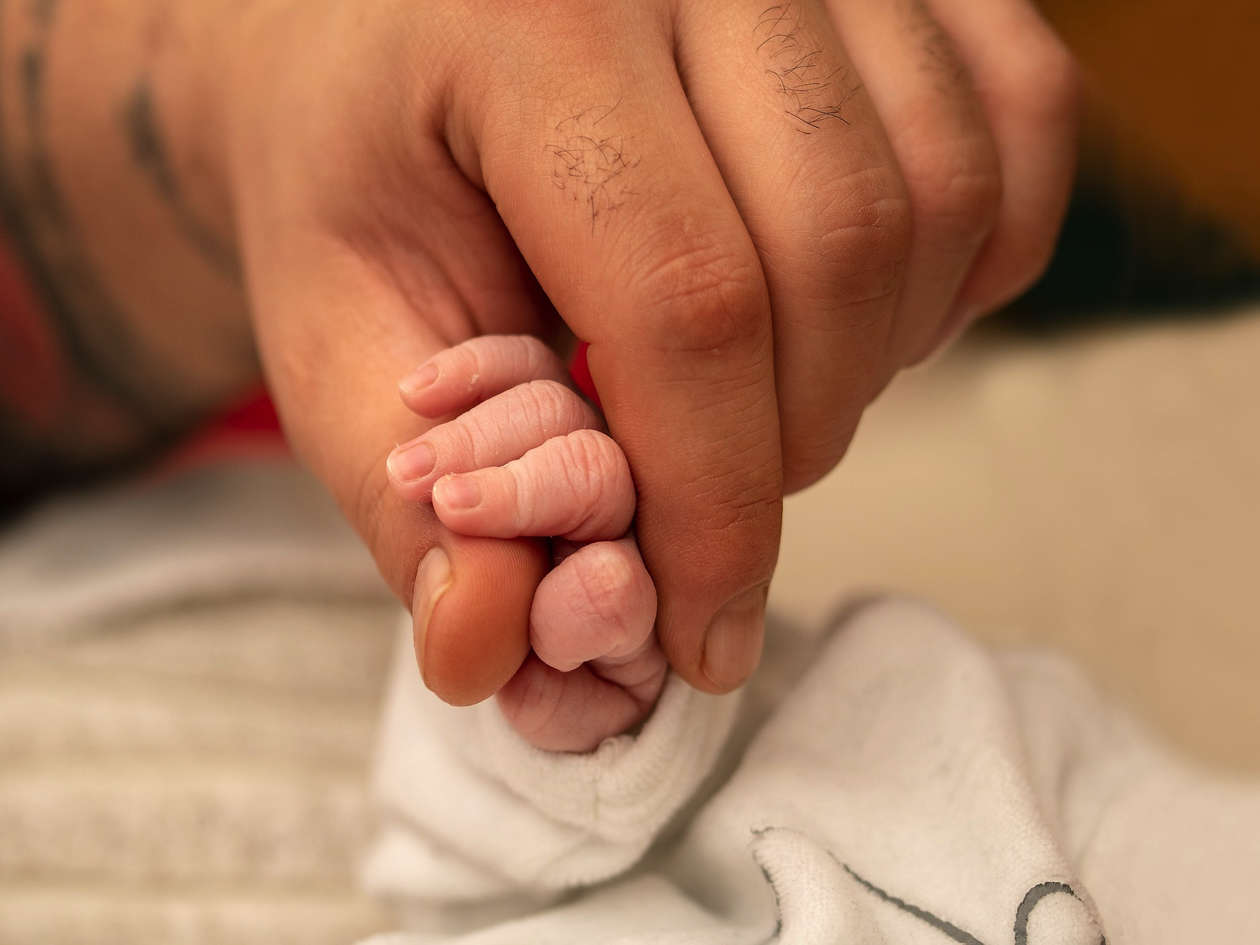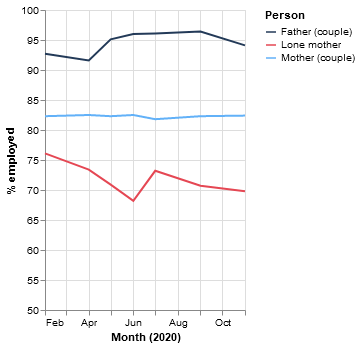Since the start of the pandemic, almost one year ago, many people’s jobs have been affected, either through redundancy, furlough or reduced hours.
The sectors in which men or women are more likely to work have affected how hard individuals have been hit. For example, the service sector, in which women are more likely to work, has been disrupted by lockdowns (Alon et al, 2020).
But women are also more likely to be key workers, and for those not working in locked down sectors, more likely to be able to work from home (Blundell et al, 2021), while manufacturing, which has seen output decline at a similar rate to the service sector, disproportionately employs men (Office for National Statistics, ONS, 2020).
Official data do not indicate that the effects of the pandemic on employment are strongly gendered. Indeed, for those under 25, young women have fared better than young men. Yet studies report that women, more than men, have stopped working or reduced their hours to care for children. Single mothers, who were already economically vulnerable before the pandemic, have been most disadvantaged by the events of the past year.
As a result, there continues to be widespread concern about how the pandemic is shaping gender equality at work and, in particular, about how mothers are faring.
What is the evidence that the crisis has disproportionately affected women’s employment?
Looking at overall employment data provides little indication that the events of the past year have affected women more adversely than men. ONS statistics show that thanks to the Coronavirus Job Retention Scheme (CJRS), employment rates have largely held up since the onset of the pandemic.
Between the final quarters (October to December) of 2019 and 2020, the employment rate for women fell slightly (0.6 percentage points to 71.8%). The drop was larger for men (2.4 percentage points to 78.2%). This indicates that, if anything, gender gaps in employment have narrowed.
That employment has not fallen further illustrates how effective the furlough scheme has been at protecting jobs, even when employees have not been working. But looking at the number of workers who are furloughed gives a better indication of how the pandemic would have affected employment in the absence of the scheme. Crucially, this also gives an idea of the potential consequences when the scheme ends.
At the May 2020 peak of the CJRS, 30% of employees were on furlough; by November 2020, this had fallen to 12%. Looking at differences by gender, for those over 25 years old, there are few differences in the number or share of workers taking up furlough (HM Revenue & Customs, 2021).
Data from Understanding Society’s Covid-19 survey give a detailed picture of people’s circumstances, including changes in the share of the men and women who were employed or self-employed, who were working positive hours or who had reduced their hours between February and April or May 2020 (Crossley et al, 2020).
While analysis of these data shows limited change in the employment rate, it indicates that the share of the working age population who were working any positive hours fell (by 20 percentage points). Further, 63% of those working before the pandemic had reduced their working hours.
Once again, the differences between men and women here are small. Another study also reports few gender differences in changes in employment and furlough to May 2020, and that women actually experienced slightly smaller losses of hours and earnings during the first lockdown (Hupkau and Petrongolo, 2020).
Finally, data on the gender pay gap for April 2020, which include information on workers on furlough, show that despite the substantial effect of coronavirus on hours of work and pay, it does not appear to have disproportionately affected women. For all employees, the pay gap fell from 17.4% to 15.5% (ONS, 2020).
Overall then, there is little evidence for the Covid-19 recession disproportionately affecting women. Nonetheless, it is worth remembering that at the onset of the pandemic, women had lower rates of employment, lower hours of work and lower earnings than men. As with past recessions, it appears that women may have, if anything, not fared as badly as men and that, for women as whole, this has helped to reduce gender inequalities (Harkness, 2013; Hoynes et al, 2012).
How has parental employment fared?
While there is little evidence for widening gender inequalities on average, much of the discussion about the gendered impact of the pandemic has focused on how school and nursery closures have affected women. Caring for children has long been a source of labour market disadvantage for women.
Among couples, new mothers are far more likely to reduce their working hours or withdraw from paid work than new fathers, who typically see their employment rates and working hours increase once children are born (Harkness et al, 2019).
Early evidence from lockdown shows that women have carried the lion’s share of the additional burden of caring for children during the pandemic (Andrews et al, 2020). This has led to concerns that mothers may have had to give up work or take unpaid leave in order to care for children. For single mothers, providing care and maintaining employment during the pandemic will have been especially challenging, and damaging for their future employment and earnings prospects.
So, have mothers fared less well in the labour market than fathers, or those without children, during the crisis? And how have fathers been affected? Data from Understanding Society’s Covid-19 survey allow us to trace changes in employment and working hours from before the restrictions were introduced (in February 2020) through to November 2020.
Figure 1 shows that among two-parent families, the employment rates of mothers and fathers have barely changed since the onset of the pandemic. But the share of parents working any positive hours has shown a sharp decline (falling 22 percentage points for fathers and 27 percentage points for mothers) between February and April 2020.
While these shares then began to recover, the November data show a further downturn. The chart also shows that the share of fathers working positive hours recovered more quickly than mothers in couples, being just slightly (6 percentage points) lower in November 2020 than February 2020, while for mothers a larger (14 percentage points) gap remained.
Single mothers, however, have fared worst of all with their employment rate being lower (6 percentage points) in November than before the pandemic and the share working any positive hours being even lower (15 percentage points).
Overall, the data from Understanding Society show that with the easing of restrictions towards the end of 2020, the share of fathers working positive hours had recovered close to their pre-pandemic rates, but for mothers, particularly single mothers, they continued to lag.
Figure 1: Changes in employment and in share working positive working hours (age>25)
Source: Understanding Society
The data also show that for those aged 25 or over, women who are not living with children have seen smaller falls in their employment and in the probability of working positive hours than mothers, although single men have also fared relatively poorly in the labour market since the pandemic began.
What about young people?
While young people have been particularly adversely affected by lockdown, there is also evidence that young men – who were already faring less well in the labour market than young women prior to the crisis – have been more adversely affected (Major et al, 2020).
By the final quarter of 2020, the employment rates of young men (ages 16-24) had fallen (9 percentage points) with unemployment reaching 16.3%. Young women also saw their position deteriorate, but less sharply: their employment rates fell 6 percentage points and unemployment reached 12.3% (House of Commons Library, 2021).
What conclusions can we draw?
Taken together, the evidence shows that the impact of the coronavirus crisis on men and women’s employment prospects has not been strongly gendered. Indeed, there is some evidence that gender gaps in employment, hours and earnings may have narrowed, particularly between young men and women.
But for parents, gender still matters. Their employment was more affected than those without children during the first lockdown and slower to recover as measures were eased. Studies of the first lockdown have reported that parents – and particularly mothers – were under enormous time pressure, leading to more mothers than fathers withdrawing from work or taking furlough (Andrews, 2020).
For single mothers, the economic pressures associated with lockdown and the increase in caring responsibilities associated with school and nursery closures have left them among the most disadvantaged by the pandemic. The one-in-four families with children headed by single parents were already among the most economically disadvantaged, and the response to the pandemic is likely to have pushed up rates of worklessness and child poverty among this group.
As the country entered a further lockdown in January 2021, with schools once again closed to the majority of children until early March, the impact of the Covid-19 recession on economic inequalities between mothers and fathers may have become yet starker.
Read the original article on the ESRC Economics Observatory website here.

